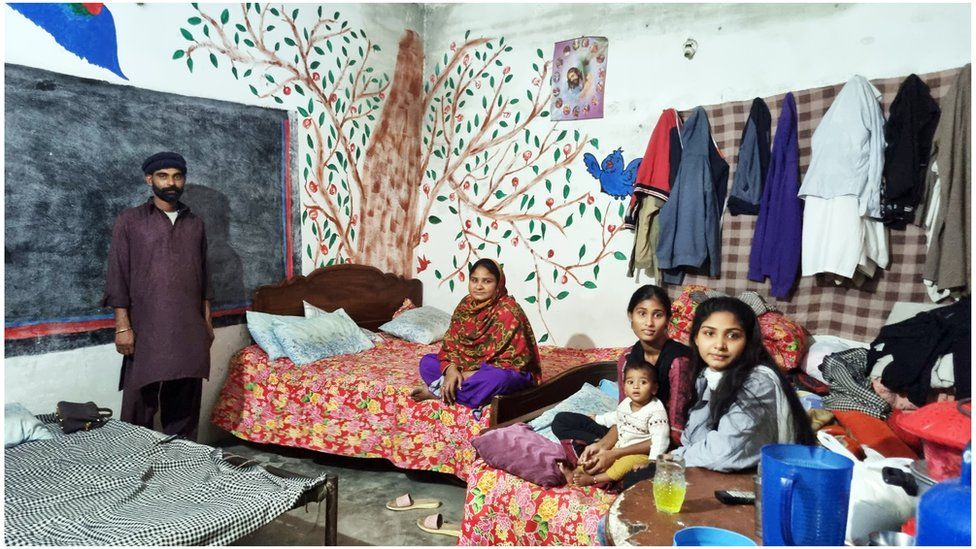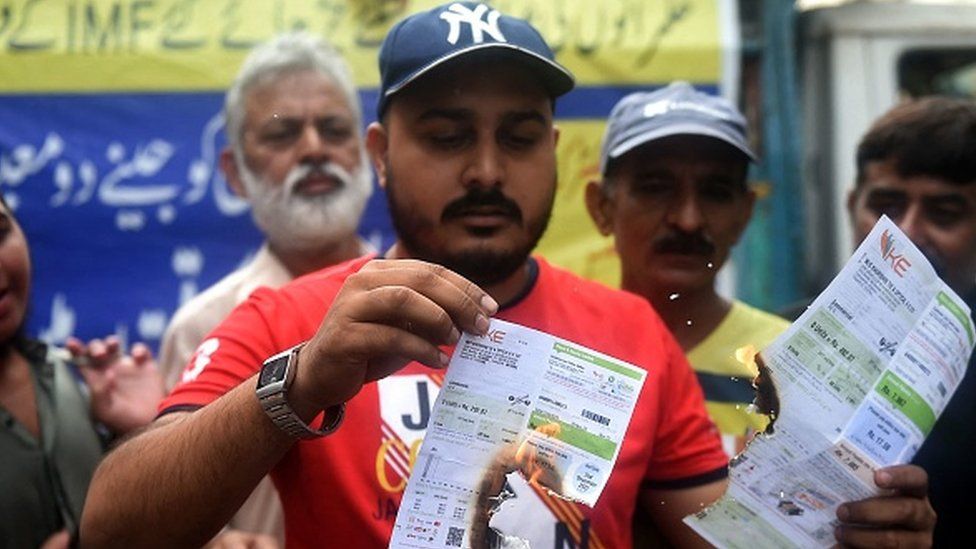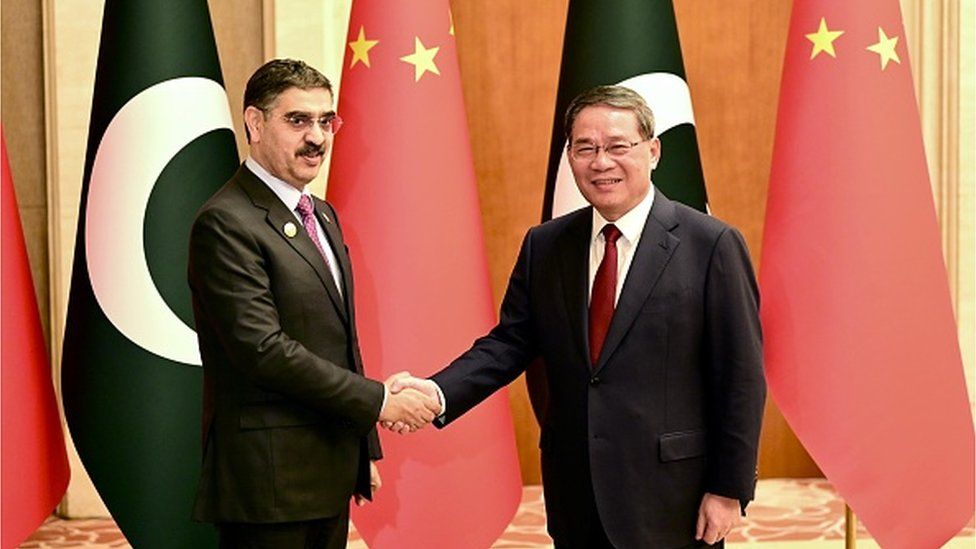Pakistan economy: Price spikes, political woes hit millions
-
Published

Daily-wage labourer Asif Maseeh wakes up each day wondering how he will feed his family of seven.
“We just pray to God that we’ll find a way to eat tomorrow,” Mr Maseeh told the BBC.
The 45-year-old is among an estimated 700,000 workers who have lost their jobs in recent years, following the closure of about 1,600 clothing factories in crisis-hit Pakistan. This amounts to a third of the country’s textile factories, which contribute to 60% of the country’s total export earnings.
Mr Maseeh started doing manual work and driving an autorickshaw after he was laid off earlier this year from his job at a factory that made clothes for global fashion brands.
Sitting in a dimly lit one-room apartment in the industrial area of Youhanabad in Lahore, Mr Maseeh and his wife Shamim Asif described how the escalating cost of living is impacting them and their five children. The couple work extra-long hours to feed their three daughters and two sons, none of whom go to school.
“We used to somehow manage our daily expenses within 500 Pakistani rupees (£1.40; $1.75) a day. Now things have changed. To cook just one meal, we need 1,500 rupees,” Mr Maseeh said.
His wife added: “Our earnings are not enough even to provide a good meal. How can we afford to send our children to school?”
Mr Maseeh is just one of millions hit by Pakistan’s ongoing economic crisis, as the country receives yet another bailout from the International Monetary Fund (IMF) – the 23rd since 1958. Last month, interim finance minister Shamshad Akhtar even raised the prospect of seeking an additional IMF loan due to the “fragile” economy, Bloomberg reported.
And there is more uncertainty on the horizon, with soaring inflation, energy prices due to increase further in January and a general election looming in February.
Industrialists in Karachi, a transport hub and Pakistan’s largest city, have even threatened to shut down production completely on 4 December, unless the government reverses unprecedented gas tariff hikes.
Many Pakistanis have already been forced to seek additional income, following sharp increases in the prices of energy and other essential commodities. This is partly a consequence of the IMF’s lending conditions, which led the government to phase out energy subsidies.

The inflation rate fell to 29% in November after hitting a record 38% in June. In recent years, essential food items like wheat flour, meat, and rice have at times more than doubled in cost, in what economist and former finance minister Miftah Ismail called a “disastrous” situation for the poor and the working class.
While the war in Ukraine, a sluggish post-pandemic recovery and fluctuating energy prices have impacted the cost of living globally – and contributed to the shuttering of the 1,600 clothing factories – Pakistan also has its own problems.
A political crisis broke out in April 2022 after then prime minister Imran Khan was ousted by a parliamentary vote. Protest rallies were held for months, paralysing economic activity. An interim caretaker administration is currently in charge until next year’s election.
Devastating floods also killed more than 1,700 people and inundated vast tracts of agricultural land during the monsoon season last year. The World Bank estimated that the total damage and economic cost was around $30bn (£24bn).
Pakistan has also faced a security crisis with a series of attacks and suicide bombings by Islamist militants, who want to impose a harsh version of Sharia law.
With its varied, expansive geography and a youthful population, Pakistan should be attractive to investors, especially for labour-intensive industries like clothing or automobile manufacturing. But in addition to the current instability, decades of conflict in neighbouring Afghanistan have also affected the country, with millions of Afghan refugees crossing the border.
“The perception of Pakistan is not very good in the rest of the world. There is an image problem in terms of law and order and also that it’s not being a friendly place to do business,” Mr Ismail said.
With debts to repay and a rising imports bill, Pakistan’s foreign exchange reserves held by its central bank fell below $3bn earlier this year – not even enough to pay for a month’s worth of imports.
After negotiations that lasted months, Islamabad finally managed to obtain $3bn in emergency funding from the IMF in July. Allies like China, Saudi Arabia and the UAE have also helped to bolster its foreign currency reserves.
Ahead of a review of the IMF lending programme, the interim government in October sharply increased natural gas prices for most households and industries, in order to reduce losses for the state-run gas sector. For example, a fixed tariff for more than half of household consumers has shot up from 10 rupees a month to 400 rupees.

“Our electricity prices have just doubled. Factories that are unable to bear the escalating cost of production are shutting down, leading to thousands of job losses,” Kamran Arshad, the Chairman of All Pakistan Textile Mill Association, North Zone, told the BBC.
The ongoing economic turmoil and a lack of job opportunities have led thousands to leave the country, with many undertaking dangerous and illegal journeys through rough seas in overcrowded rickety boats. Hundreds of Pakistanis died when an overloaded trawler full of immigrants capsized off southern Greece in June.
“The government has lost credibility with its own citizens. The economic environment is dire. So, people are willing to risk a lot to get out”, said Sabrin Beg, an associate professor of economics at the University of Delaware.
A decade ago, when Pakistan fought a war against Islamist militants in the north-west, investors were wary – except China, which poured billions of dollars into the economy. It even calls Pakistan its “Iron Brother,” playing up the closeness of their relationship.
Under the Belt and Road Initiative, China is investing more than $60bn in the China-Pakistan Economic Corridor (CPEC), which began in 2015. This connects the Pakistani port of Gwadar in the Arabian sea to China’s north-western region of Xinjiang through a network of highways, railways and pipelines.
It is hoped that the project, China’s biggest overseas investment, will help boost Pakistan’s economy. But analysts are concerned as to whether the investments will generate enough revenue to pay back the Chinese loans. The IMF estimates that Pakistan owes around $30bn to China.
“The Chinese investment is promising. But we are building infrastructure through borrowed funds and as a result, we are exposing ourselves to liability. A lender like China will get their money back somehow,” said Prof Beg.
Even with the backing of an Iron Brother, any new government that takes over after the February elections will have its work cut out reviving the economy.
Additional reporting by Amel Ghani in Lahore
